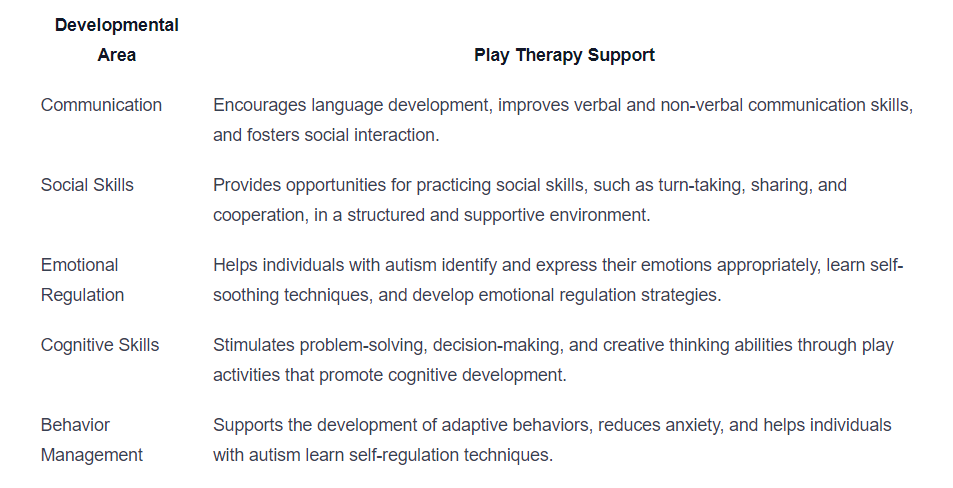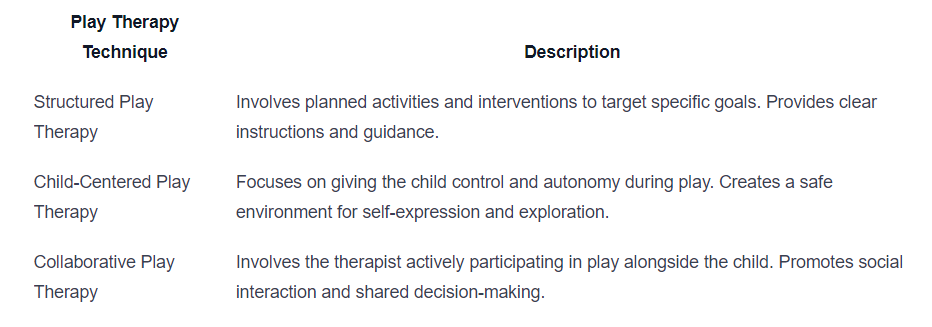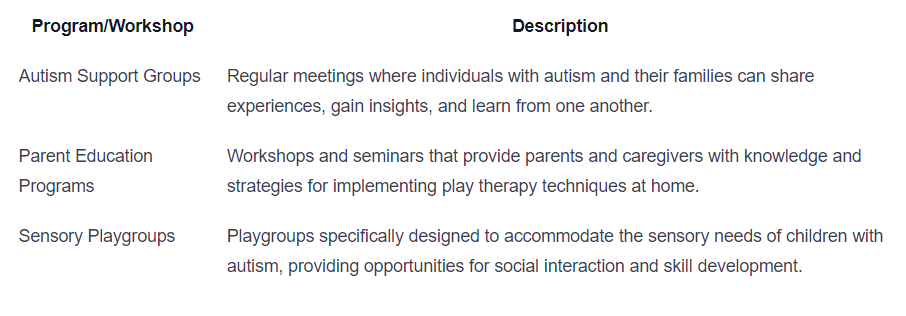What is Play Therapy for Autism?
Unlock the power of play therapy for autism. Discover how it supports development and benefits individuals with autism.

Understanding Autism and Play Therapy
Play therapy is a valuable therapeutic approach for individuals with Autism Spectrum Disorder (ASD). To grasp the power of play therapy in the context of autism, it is important to have an understanding of Autism Spectrum Disorder itself and the concept of play therapy.

Overview of Autism Spectrum Disorder
Autism Spectrum Disorder is a neurodevelopmental condition characterized by challenges in social interaction, communication, and repetitive patterns of behavior. It is a spectrum disorder, which means that individuals with autism can exhibit a wide range of abilities and symptoms.
ASD affects individuals differently, with some experiencing mild difficulties while others may face more significant challenges. Common characteristics of autism include difficulties in social communication, sensory sensitivities, restricted interests, and repetitive behaviors.
What is Play Therapy?
Play therapy is a form of therapy that utilizes play as a means of communication and expression. It provides a safe and supportive environment for individuals to explore their thoughts, emotions, and behaviors. Play therapy is particularly effective for children, as play is a natural way for them to learn, communicate, and process their experiences.
In the context of autism, play therapy focuses on addressing the unique needs and challenges faced by individuals on the spectrum. Through play, therapists can engage children in activities that promote social interaction, communication skills, emotional regulation, and cognitive development.
Play therapy for autism is often tailored to the individual's specific goals and preferences. Therapists use a variety of techniques and interventions to create a meaningful and therapeutic play experience. This can include structured activities, role-playing, pretend play, and sensory-based play to address the sensory sensitivities commonly associated with autism.
By harnessing the power of play, play therapy provides a platform for individuals with autism to learn and grow in a supportive and enjoyable setting. It allows therapists to meet the unique needs of each individual and promote their overall development and well-being.
Understanding autism and the concept of play therapy sets the stage for exploring the importance of play therapy for individuals with autism. By delving into the benefits of play therapy and the different techniques used, we can further appreciate the role it plays in supporting individuals on the autism spectrum.
Importance of Play Therapy for Autism
Play therapy plays a vital role in supporting individuals with autism spectrum disorder (ASD) by providing a therapeutic and developmentally appropriate intervention. This section will highlight the benefits of play therapy for individuals with autism and explain how play therapy supports their overall development.
Benefits of Play Therapy for Individuals with Autism
Play therapy offers a wide range of benefits for individuals with autism. Here are some key advantages:
- Enhances Communication Skills: Play therapy provides a safe and engaging environment for individuals with autism to practice and develop their communication skills. It helps them learn to express themselves, understand social cues, and improve their language abilities.
- Promotes Emotional Regulation: Engaging in play activities allows individuals with autism to explore and express their emotions in a non-threatening way. Play therapy helps them develop emotional awareness and regulation strategies, which can be particularly beneficial for individuals who struggle with emotional challenges.
- Improves Social Interaction: Play therapy encourages social interaction and fosters the development of social skills. Through play, individuals with autism can learn turn-taking, sharing, cooperation, and other vital social skills necessary for successful interactions with peers and family members.
- Increases Cognitive Abilities: Play therapy stimulates cognitive development by promoting problem-solving, creative thinking, and decision-making skills. It helps individuals with autism develop their cognitive abilities while engaging in enjoyable activities.
- Reduces Anxiety and Improves Behavior: Play therapy provides a structured and supportive environment that can help reduce anxiety and improve behavior in individuals with autism. It allows them to practice coping strategies, learn self-regulation techniques, and develop adaptive behaviors.
How Play Therapy Supports Development
Play therapy supports the overall development of individuals with autism by targeting specific areas of need. Here's how play therapy contributes to different aspects of development:

By understanding the benefits of play therapy for individuals with autism and how it supports their development, parents, caregivers, and therapists can make informed decisions about incorporating play therapy into their intervention plans. Play therapy offers a unique and effective approach to help individuals with autism reach their full potential and improve their overall well-being.
Types of Play Therapy Techniques
When it comes to play therapy for individuals with autism, different techniques are utilized to meet the unique needs of each child. These techniques are designed to create a safe and engaging environment that promotes growth, development, and social interaction. Let's explore three commonly used play therapy techniques for autism: structured play therapy, child-centered play therapy, and collaborative play therapy.
Structured Play Therapy
Structured play therapy involves the use of carefully planned activities and interventions that are designed to target specific goals. The therapist provides clear instructions and guidance throughout the session, using play materials and toys that are chosen to support the individual's developmental needs and interests.
This type of play therapy often follows a set schedule and incorporates specific strategies to promote skill-building and communication. Structured play therapy can help individuals with autism develop important social and cognitive skills, such as turn-taking, following instructions, and problem-solving.
Child-Centered Play Therapy
Child-centered play therapy is a technique that focuses on giving the child control and autonomy during the play session. The therapist creates a safe and accepting environment where the child can freely explore their interests and express themselves through play.
In child-centered play therapy, the therapist acts as a supportive presence, allowing the child to lead the play while providing unconditional positive regard. This technique encourages self-expression, creativity, and emotional development. It can help individuals with autism build self-confidence, improve communication skills, and develop a sense of agency.
Collaborative Play Therapy
Collaborative play therapy involves the therapist actively participating in the play session alongside the child. The therapist engages in joint play activities, taking on the role of a playmate or co-player. This technique promotes social interaction, cooperation, and shared decision-making.
By participating in play together, the therapist can model appropriate social behaviors, problem-solving skills, and communication strategies. Collaborative play therapy encourages individuals with autism to develop social connections, improve social skills, and enhance their ability to engage in reciprocal play.
Each play therapy technique has its own unique benefits and can be tailored to meet the specific needs of the individual with autism. By incorporating these techniques into therapy sessions, therapists can create a supportive and enriching environment that promotes growth, development, and positive social interaction.

It's important to remember that play therapy techniques should be implemented by trained professionals who have expertise in working with individuals with autism. The therapist will assess the needs of the child and determine which technique or combination of techniques will be most effective in promoting their development and well-being.
Incorporating Play Therapy in Autism Interventions
To effectively address the unique needs of individuals with autism, play therapy is often incorporated as a key component in autism interventions. This section will explore the importance of individualized therapy plans and the role of therapists and caregivers in implementing play therapy for autism.
Individualized Therapy Plans
Individualized therapy plans play a crucial role in the success of play therapy for individuals with autism. These plans are tailored to meet the specific needs, strengths, and challenges of each individual. By taking into consideration the child's developmental level, interests, and preferences, therapists can create a therapy plan that maximizes engagement and progress.
The individualized therapy plan may include various play therapy techniques and goals, such as improving social skills, communication, emotional regulation, and sensory integration. By setting specific and measurable objectives, therapists can track the child's progress and make adjustments as needed.
It is important to note that individualized therapy plans are not static, but rather dynamic and flexible. As the child progresses and develops new skills, the therapy plan can be adjusted accordingly to provide continued support and challenge.
Role of Therapists and Caregivers
Therapists and caregivers play a vital role in implementing play therapy for autism. They work collaboratively to create a supportive and enriching environment for the child. Here are some key aspects of their roles:
- Therapists: Trained therapists with expertise in play therapy for autism guide and facilitate the therapy sessions. They create a safe and structured space where the child can explore, learn, and practice new skills. Therapists carefully observe the child's interactions and provide appropriate support and guidance. They also collaborate with caregivers to ensure consistency and reinforce skills learned during therapy.
- Caregivers: Caregivers, including parents, family members, and other significant individuals in the child's life, play an essential role in supporting the child's development outside of therapy sessions. They actively participate in the therapy process by implementing strategies and techniques learned during therapy at home and in daily routines. Caregivers provide a nurturing and supportive environment that encourages the child to generalize skills learned during play therapy to real-life situations.
By working together, therapists and caregivers can create a holistic approach to play therapy for autism. This collaboration ensures that the child receives consistent support and opportunities for growth in various settings.
It is important to note that while play therapy can be a valuable intervention for individuals with autism, it is most effective when integrated with other evidence-based approaches such as speech therapy, occupational therapy, and behavioral interventions. The coordinated efforts of a multidisciplinary team can provide a comprehensive and individualized approach to address the diverse needs of individuals with autism.
Implementing Play Therapy at Home
Play therapy can be a valuable addition to autism interventions, and it can also be incorporated at home to provide continuous support for individuals with autism. Implementing play therapy techniques in a safe and supportive environment, as well as integrating them into the daily routine, can greatly benefit the development and well-being of individuals with autism.
Creating a Safe and Supportive Environment
When implementing play therapy at home, creating a safe and supportive environment is essential. Consider the following factors to ensure a conducive space for play therapy:
- Physical Space: Dedicate a specific area in your home for play therapy sessions. This area should be free from distractions and provide enough room for movement and exploration.
- Safety Measures: Make sure the play area is child-proofed and free from potential hazards. Remove any sharp objects or items that could pose a danger during play.
- Sensory Considerations: Take into account the sensory needs of the individual with autism. Adjust the lighting, noise level, and temperature in the play area to create a sensory-friendly environment.
- Comfort and Familiarity: Include objects, toys, or materials that are familiar and comforting to the individual. This can help create a sense of security and encourage engagement in play therapy.
By creating a safe and supportive environment, you can enhance the effectiveness of play therapy and provide a nurturing space for growth and development.
Integrating Play Therapy Techniques in Daily Routine
To maximize the benefits of play therapy, it's important to integrate play therapy techniques into the daily routine. Here are some strategies to incorporate play therapy at home:
- Structured Play Time: Set aside dedicated playtime each day. This can be a specific duration where you engage in play therapy activities with the individual. Use this time to focus on their specific goals and incorporate techniques recommended by the therapist.
- Visual Schedules: Utilize visual schedules to help individuals with autism understand and anticipate their daily routine. Incorporate play therapy sessions into the schedule to provide a sense of structure and predictability.
- Choice-making Opportunities: Offer choices during play therapy sessions to encourage decision-making skills. For example, allow the individual to choose between different toys or activities. This promotes autonomy and fosters a sense of empowerment.
- Naturalistic Play: Integrate play therapy techniques naturally throughout the day. Find opportunities for play-based interactions during daily activities, such as mealtime or bath time. This helps generalize skills learned in play therapy to real-life situations.
By integrating play therapy techniques into the daily routine, you can create a consistent and supportive environment that promotes skill development, communication, and emotional well-being in individuals with autism.
Remember, it's important to work closely with a qualified therapist to develop an individualized play therapy plan that suits the specific needs and goals of the individual with autism. They can provide guidance, monitor progress, and recommend appropriate techniques for implementation at home. Additionally, accessing professional services and community programs can provide further support and resources for implementing play therapy effectively.
Resources and Support for Play Therapy
When it comes to accessing resources and support for play therapy in the context of autism, there are several options available to individuals and families. These resources can provide valuable guidance, assistance, and professional expertise in implementing play therapy techniques for children with autism.
Accessing Professional Services
Professional services play a crucial role in the successful implementation of play therapy for autism. Qualified professionals, such as licensed therapists and psychologists, can provide specialized knowledge and expertise to support individuals with autism. They can tailor therapy plans to meet the unique needs of each child and guide caregivers in implementing effective play therapy techniques.
Here are some professional services that can be helpful in accessing play therapy for autism:

It's important to research and choose professionals who have experience and knowledge in working with individuals with autism. This ensures that the therapy provided is tailored to the specific needs and goals of each child.
Community Programs and Workshops
Community programs and workshops can be valuable resources for individuals and families seeking support and guidance in play therapy for autism. These programs often provide a range of services, including playgroups, educational workshops, and networking opportunities. They can offer a supportive community where individuals with autism and their families can connect with others facing similar challenges.
Here are some examples of community programs and workshops that can support play therapy for autism:

Community programs and workshops can be found through local autism organizations, community centers, and online resources. They offer a valuable platform for learning, collaboration, and support in the journey of implementing play therapy for autism.
By accessing professional services and engaging in community programs and workshops, individuals and families can gain the necessary resources and support to effectively implement play therapy techniques for autism. Remember to consult with professionals and research local resources to find the most suitable options for your specific needs and goals.
Sources
https://www.totalcareaba.com/autism/play-therapy
https://www.verywellhealth.com/play-therapy-and-autism-the-basics-260059
https://abacentersfl.com/blog/7-incredible-benefits-of-play-therapy/
Similar articles
We’re here to help you

Our team is here to assist you in this process. Contact us for any assistance.
it’s easy to apply
We Accept Most Insurances
Our in-network insurance partnerships make ABA therapy more accessible to families throughout our service areas.







Our Insurance Process
We'll request your insurance details to help us verify your plan's coverage for ABA therapy. Once we've received this information, we'll walk you through your benefits, including copayments, deductibles and out-of-pocket maximums, so you know what to expect in advance.
Our team will then handle the preauthorization and all the necessary paperwork.
.svg)





















.jpeg)


































.jpeg)




.jpeg)







.jpeg)











.jpeg)
















